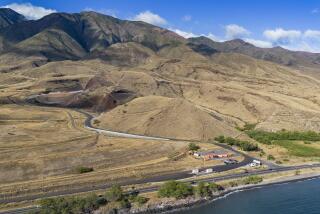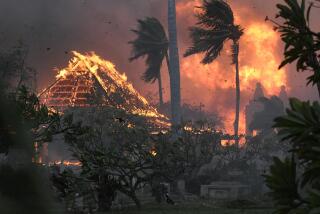Hawaiians Sue NASA Over Telescope
- Share via
A Hawaiian government body has sued NASA, charging that the construction of new telescopes atop the islands’ tallest peak could threaten areas deemed sacred by many residents.
The Office of Hawaiian Affairs, a semiautonomous state agency set up to improve the condition of Hawaii’s native population, filed the suit late Monday in U.S. District Court in Hawaii to try to force NASA to slow down plans to expand the Keck telescope. The suit asks that NASA be required to conduct a full environmental impact review before it proceeds with building four to six small “outrigger” telescopes to boost the capabilities of the Keck, which consists of two 10-meter telescopes that are each the world’s largest gatherers of starlight.
“The cultural sensitivities have not been appropriately addressed,” said Haunani Apoliona, chairwoman of the Office of Hawaiian Affairs. “The issues have been ignored. We had no choice but to file legal action.”
Mauna Kea, a dormant volcano on Hawaii’s Big Island, is the setting for 13 telescopes. The top of the mountain is coveted by astronomers because it rises above the cloud layer into thin, clear air that provides excellent viewing of the heavens. It is also more convenient to reach than other good viewing spots in the Chilean desert and Antarctica.
Many Hawaiian residents have become increasingly upset about development and construction on the mountain, which is home to hundreds of sacred shrines and ancient burial grounds as well as a rare high-altitude insect called the Weiku bug. In Hawaii’s naturalistic religion, the 13,769-foot mountain is considered the piko, or navel of Hawaii, from which all else arose. Hawaiians call it their sacred temple.
“The role that this mountain plays in Hawaiian culture and religion is unquestioned throughout Polynesia,” said Kealoha Pisciotta, a native Hawaiian and former telescope employee who is leading efforts to protect the mountain.
The battle over Mauna Kea has crescendoed in parallel with a growing native Hawaiian political movement. The calls by elders, religious leaders and other local Hawaiians against more construction on the mountain have been joined by Sierra Club leaders who fear environmental degradation of the mountain.
NASA Asked to Give Back to Community
The development of astronomy in Hawaii had long been seen as a way to improve the economy and educational resources of the state. Over the last few years, though, the effort has become more controversial. In 1998, state officials published a scathing audit that lambasted management of the summit.
Some Hawaiians are calling for a ban on new telescopes or even removal of the existing ones. Others want better stewardship of the mountain, which has had some of its cinder cones flattened in preparation for telescope placement.
Ed Stevens, a Hawaiian elder who worships on the mountain and leads a group called Ahahui Ku Mauna--”group for the mountain”--is urging that a full impact assessment of development on the summit be conducted and also that the astronomers reimburse the state for use of the mountain. Some have suggested that the telescopes fund educational opportunities for Hawaiians.
Viewing time at Keck is worth roughly $1 per second, or $30,000 per night. Each telescope pays the state a rental fee of $1 per year.
But a proposal by NASA to offer $1.85 million to native causes was met with derision. “We found the offer not only ridiculous but totally insulting,” Pisciotta said. “There is no way to compensate [for] the destruction, desecration or possible injury to an endangered species and the sacred waters of Mauna Kea.”
Keck is run jointly by NASA, the University of California and Caltech. Telescope officials and a NASA spokesman said Tuesday they would not comment on any pending litigation.
The proposed outrigger telescopes are 6 feet across and would be built around the edge of the two 33-foot-wide Keck telescopes. Once in place and linked to the main telescope through a technique called interferometry, they would greatly increase the telescopes’ ability to see distant objects clearly.
The improvements mean the telescopes might be able to make maps of nearby planets and galaxies. This is a key part of NASA’s Origins project, an attempt to seek life elsewhere in the galaxy.
The project has now been delayed by a year and a half. Conducting a full environmental impact statement could delay matters for an additional year, NASA officials have said.
NASA officials, who have said they are concerned about protecting the mountain, did conduct a less formal environmental assessment and said the project would have “no significant impact.”
The fight over the Keck outriggers is seen as a test case for other projects designed for the mountain. One telescope three times the size of Keck is now on the drawing board at UC Santa Cruz and may be destined for Mauna Kea.
More to Read
Sign up for Essential California
The most important California stories and recommendations in your inbox every morning.
You may occasionally receive promotional content from the Los Angeles Times.










